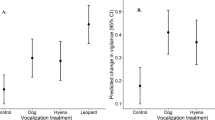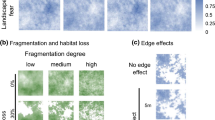Abstract
Non-consumptive effects (NCEs) of predators are ubiquitous in food webs with well-detailed impacts on trophic cascades over multiple levels. However, integrating NCEs with other predator–mediated interactions, like intraguild predation, as well as context-specific habitat factors that shape top–down pressure, remains a challenge. Focusing on two common seed predators, mice (Peromyscus spp.) and carabid beetles (Coleoptera: Carabidae), we quantify trophic and behavioral consequences of predation risk and availability of refuge vegetation on both intraguild predators (mice) and intraguild prey (beetles). In a 2-year field experiment, we manipulated refuge habitat (red clover), small mammal access, and moonlight, which small mammals use as an indirect cue of predation risk. We found that avoidance of predation risk by mice in simulated moonlight reduced carabid activity density in vegetation by up to 50% compared to exposed habitat, but had no cascading effects on seed predation. We linked patterns observed in the field with behavioral mechanisms by observing beetle foraging activity, and found that exposure to both indirect and direct vertebrate predator cues reduced movement by 50%, consistent with predator–mediated activity reductions observed in the field. However, predation risk increased carabid seed consumption by 43%. Thus, weak effects of predation risk on seed removal in the field may be explained by overcompensatory seed feeding by beetles. This work demonstrates that predators elicit responses that cascade over multiple trophic levels, triggering behavioral changes in species lower on the food chain. These behavior-mediated cascades are controlled by their spatiotemporal context and have important downstream impacts on predator–prey dynamics.




Similar content being viewed by others
References
Abramsky Z, Rosenzweig ML, Subach A (2002) The costs of apprehensive foraging. Ecology 83:1330–1340
Bates D, Maechler M, Bolker B, Walker S (2014) lme4: linear mixed-effects models using Eigen and S4. R package version 1(7):1–23
Bestion E, Cucherousset J, Teyssier A, Cote J (2015) Non-consumptive effects of a top-predator decrease the strength of the trophic cascade in a four-level terrestrial food web. Oikos 124:1597–1602
Birthisel SK, Gallandt ER, Jabbour R (2014) Habitat effects on second-order predation of the seed predator Harpalus rufipes implications for weed seedbank management. Biol Control 70:65–72
Blubaugh CK, Kaplan I (2015) Tillage compromises weed seed predator activity across developmental stages. Biol Control 81:76–82
Bolnick DI, Preisser EL (2005) Resource competition modifies the strength of trait-mediated predator-prey interactions: a meta-analysis. Ecology 86:2771–2779
Bricker M, Pearson D, Maron J (2010) Small-mammal seed predation limits the recruitment abundance of two perennial grassland forbs. Ecology 91:85–92
Brown JS (1988) Patch use as an indicator of habitat preference, predation risk, competition. Behav Ecol Sociobiol 22:37–47
Brown JS (1999) Vigilance, patch use and habitat selection: foraging under predation risk. Evol Ecol Res 1:49–71
Brown JS, Kotler BP (2004) Hazardous duty pay the foraging cost of predation. Ecol Lett 7:999–1014
Brust GE (1990) Direct indirect effects of four herbicides on the activity of carabid beetles (Coleoptera: Carabidae). Pest Sci 30:309–320
Cardina J, Johnson GA, Sparrow DH (1997) The nature consequence of weed spatial distribution. Weed Sci 45:364–373
Carmona DM, Landis DA (1999) Influence of refuge habitats cover crops on seasonal activity-density of ground beetles (Coleoptera: Carabidae) in field crops. Environ Entomol 28:1145–1153
Ceradini JP, Chalfoun AD (2017) When perception reflects reality: non-native grass invasion alters small mammal risk landscapes and survival. Ecol Evol 7:1823–1835
Davis A, Raghu S (2010) Weighing abiotic biotic influences on weed seed predation. Weed Res 50:402–412
DeVore JL, Maerz JC (2014) Grass invasion increases top–down pressure on an amphibian via structurally mediated effects on an intraguild predator. Ecology 95:1724–1730
Diehl E, Wolters V, Birkhofer K (2012) Arable weeds in organically managed wheat fields foster carabid beetles by resource- structure-mediated effects. Arthropod Plant Interact 6:75–82
Donelan SC, Grabowski JH, Trussell GC (2017) Refuge quality impacts the strength of nonconsumptive effects on prey. Ecology 98:403–411
Falkenberg JC, Clarke JA (1998) Microhabitat use of deer mice: effects of interspecific interaction risks. J Mammal 79:558–565
Finke DL, Denno RF (2002) Intraguild predation diminished in complex-structured vegetation: implications for prey suppression. Ecology 83:643–652
Finke DL, Denno RF (2004) Predator diversity dampens trophic cascades. Nature 429:407–410
Frago E, Godfray HCJ (2014) Avoidance of intraguild predation leads to a long-term positive trait-mediated indirect effect in an insect community. Oecologia 174:943–952
Gordon CE, Feit A, Grüber J, Letnic M (2015) Mesopredator suppression by an apex predator alleviates the risk of predation perceived by small prey. Proc Roy Soc B [Biol] 282:20142870. doi:10.1098/rspb.2014.2870
Greenslade PJM (1964) Pitfall trapping as a method for studying populations of Carabidae (Coleoptera. J Anim Ecol 33:301–310
Hairston NG, Smith FE, Slobodkin LB (1960) Community structure, population control, competition. Am Nat 94:421–425
Hawlena D, Schmitz OJ (2010) Herbivore physiological response to predation risk implications for ecosystem nutrient dynamics. Proc Nat Acad Sci USA 107:15503–15507
Hermann SL, Thaler JS (2014) Prey perception of predation risk: volatile chemical cues mediate non-consumptive effects of a predator on a herbivorous insect. Oecologia 176:69–676
Hill JM, Heck KL (2015) Non-consumptive effects of avian predators on fish behavior cascading indirect interactions in seagrasses. Oikos 124:750–761
Hulme PE (1998) Post-dispersal seed predation: consequences for plant demography evolution. Perspect Plant Ecol Evol Syst 1:32–46
Hunter MD (2009) Trophic promiscuity, intraguild predation the problem of omnivores. Agric Forest Entomol 11:125–131
Janssen A, Sabelis MW, Magalhães S, Montserrat M, Van der Hammen T (2007) Habitat structure affects intraguild predation. Ecology 88:713–2719
Kaplan I, Thaler JS (2010) Plant resistance attenuates the consumptive non-consumptive impacts of predators on prey. Oikos 119:1105–1113
Kimbro DL, Grabowski JH, Hughes AR, Piehler MF, White JW (2017) Nonconsumptive effects of a predator weaken then rebound over time. Ecology 98:656–667
Kotler BP (1984) Risk of predation and the structure of desert rodent communities. Ecology 65:689–701
Lima SL (2002) Putting predators back into behavioral predator–prey interactions. Ecol Evol 1:70–75
Lundgren JG (2009) Relationships of natural enemies non-prey foods. Springer, Dordrecht
Lundgren JG, Rosentrater KA (2007) The strength of seeds their destruction by granivorous insects. Arthropod Plant Interact 1:93–99
Matassa CM, Donelan SC, Luttbeg B, Trussell GC (2016) Resource levels and prey state influence antipredator behavior and the strength of nonconsumptive predator effects. Oikos 125:1478–1488
Meadows AJ, Crowder DW, Snyder WE (2016) Are wolves just wasps with teeth? What invertebrates can teach us about mammal top predators. Food Webs. doi:10.1016/j.fooweb.2016.09.004
Orrock JL, Danielson BJ (2004) Rodents balancing a variety of risks: invasive fire ants indirect direct indicators of predation risk. Oecologia 140:662–667
Orrock JL, Fletcher RJ (2014) An island-wide predator manipulation reveals immediate long-lasting matching of risk by prey. Proc Roy Soc Lond B [Biol] 281:20140391. doi:10.1098/rspb.2014.0391
Orrock JL, Preisser EL, Grabowski JH, Trussell GC (2013) The cost of safety: refuges increase the impact of predation risk in aquatic systems. Ecology 94:73–579
Pallini A, Janssen A, Sabelis MW (1998) Predators induce interspecific herbivore competition for food in refuge space. Ecol Lett 1:171–176
Parmenter RR, MacMahon JA (1988) Factors influencing species composition population sizes in a ground beetle community (Carabidae): predation by rodents. Oikos 52:50–356
Penteriani V, Kuparinen A, del Mar Delgado M, Palomares F, López-Bao JV, Fedriani J, Calzada J, Sacramento M, Villafuerte R, Campioni L, Lourenço R (2013) Responses of a top a meso-predator their prey to moon phases. Oecologia 173:753–766
Pinheiro J, Bates D, DebRoy S, Sarkar D, R core team (2014) nlme: linear and nonlinear mixed effects models. R package version 3.1-117. Available at http://CRAN.R-project.org/package=nlme
Polis GA, Holt RD (1992) Intraguild predation: the dynamics of complex trophic interactions. Trends Ecol Evol 7:151–154
Polis GA, Strong DR (1996) Food web complexity community dynamics. Am Nat 147:813–846
Prasad RP, Snyder WE (2006) Diverse trait-mediated interactions in a multi-predator, multi-prey community. Ecology 87:1131–1137
Preisser EL, Bolnick DI, Benard MF (2005) Scared to death? The effects of intimidation consumption in predator-prey interactions. Ecology 86:501–509
Prugh LR, Golden CD (2014) Does moonlight increase predation risk? Meta-analysis reveals divergent responses of nocturnal mammals to lunar cycles. J Anim Ecol 83:504–514
Ripple WJ, Estes JA, Schmitz OJ, Constant V, Kaylor MJ, Lenz A, Wolf C (2016) What is a trophic cascade? Trends Ecol Evol 31:842–849
Rosenheim JA, Wilhoit LR, Armer CA (1993) Influence of intraguild predation among generalist insect predators on the suppression of an herbivore population. Oecologia 96:439–449
Saska P, VanderWerf W, Hemerik L, Luff ML, Hatten TD, Honek A (2013) Temperature effects on pitfall catches of epigeal arthropods: a model method for bias correction. J Anim Ecol 50:181–189
Schmidt JM, Rypstra AL (2010) Opportunistic predator prefers habitat complexity that exposes prey while reducing cannibalism intraguild encounters. Oecologia 164:899–910
Schmitz OJ, Trussell GC (2016) Multiple stressors, state-dependence and predation risk—foraging trade-offs: toward a modern concept of trait-mediated indirect effects in communities and ecosystems. Curr Opin Behav Sci 12:6–11
Schmitz OJ, Krivan K, Ovadia O (2004) Trophic cascades: the primacy of trait-mediated indirect interactions. Ecol Lett 7:153–163
Shearin AF, Reberg-Horton CS, Gallandt ER (2008) Cover crop effects on the activity-density of the weed seed predator Harpalus rufipes (Coleoptera: Carabidae). Weed Sci 56:442–450
Sheriff MJ, Thaler JS (2014) Ecophysiological effects of predation risk; an integration across disciplines. Oecologia 176:607–611
Sih A, Englund G, Wooster D (1998) Emergent impacts of multiple predators on prey. Trends in Ecol Evol 13:350–355
Thaler JS, McArt SH, Kaplan I (2012) Compensatory mechanisms for ameliorating the fundamental trade-off between predator avoidance foraging. Proc Nat Acad Sci USA 109:12075–12080
VanderWall SB, Kuhn KM, Beck MJ (2005) Seed removal, seed predation, secondary dispersal. Ecology 86:801–806
Verdolin JL (2006) Meta-analysis of foraging predation risk trade-offs in terrestrial systems. Behav Ecol Sociobiol 60:457–464
Wallin H, Ekbom BS (1988) Movements of carabid beetles (Coleoptera: Carabidae) inhabiting cereal fields: a field tracing study. Oecologia 77:39–43
Walzer A, Schausberger P (2013) Integration of multiple cues allows threat-sensitive anti-intraguild predator responses in predatory mites. Anim Behav 150:115–132
Ward MJ, Ryan MR, Curran WS, Barbercheck ME, Mortensen DA (2011) Cover crops disturbance influence activity-density of weed seed predators Amara aenea and Harpalus pensylvanicus (Coleoptera: Carabidae). Weed Sci 59:76–81
Werner EE, Anholt BR (1993) Ecological consequences of the trade-off between growth mortality rates mediated by foraging activity. Am Nat 142:242–272
Whitaker JO (1966) Food of Mus musculus, Peromyscus maniculatus bairdi Peromyscus leucopus in Vigo County, Indiana. J Mamm 47:473–486
Zollner PA, Lima SL (1997) Landscape-level perceptual abilities in white-footed mice: perceptual range the detection of forested habitat. Oikos 80:51–60
Zuur AF, Ieno EN, Walker NJ, Saveliev AA, Smith GM (2009) Mixed effects models and extensions in ecology with R. Springer Science Business Media, New York
Acknowledgements
This material is based upon work that is supported by the National Institute of Food and Agriculture, US Department of Agriculture, under Award No. 10-51300-21305, and by NSF Award No. 1401795. We are grateful to Curt Hardin, Gareth Powell, and Christie Shee, for assistance with data collection, and several Kaplan lab members for helpful feedback on previous drafts of this manuscript. Rob Swihart, Patrick Zollner, and John Orrock offered advice on methods, and Ken Kellner helped with analysis. Jamin Dreyer, Elinor Lichtenberg, Jim Cronin and several anonymous reviewers provided valuable comments that shaped the final version of this paper.
Author information
Authors and Affiliations
Contributions
CKB and IK conceived and designed the experiment; CKB and IVW conducted fieldwork; CKB and IVW analyzed the data. CKB, IVW, and IK wrote the manuscript.
Corresponding author
Ethics declarations
Ethical approval
All applicable institutional and/or national guidelines for the care and use of animals were followed.
Additional information
Communicated by Jennifer Thaler.
While most studies examine trophic consequences of predation risk, we show that anti-predator behavior may in turn trigger another series of predator avoidance responses at lower trophic levels, or ‘fear cascades’ mediated by refuge and resource availability. This discovery is important because it emphasizes the central importance of spatiotemporal context for understanding predator–prey interactions; these should be examined explicitly in future work.
Electronic supplementary material
Below is the link to the electronic supplementary material.
Rights and permissions
About this article
Cite this article
Blubaugh, C.K., Widick, I.V. & Kaplan, I. Does fear beget fear? Risk-mediated habitat selection triggers predator avoidance at lower trophic levels. Oecologia 185, 1–11 (2017). https://doi.org/10.1007/s00442-017-3909-1
Received:
Accepted:
Published:
Issue Date:
DOI: https://doi.org/10.1007/s00442-017-3909-1




